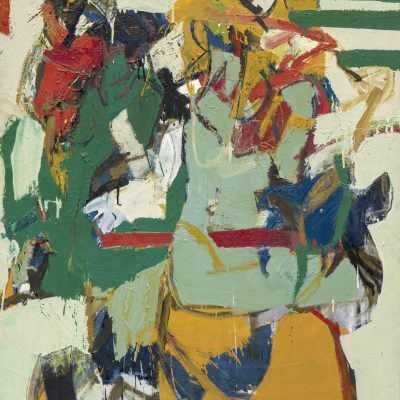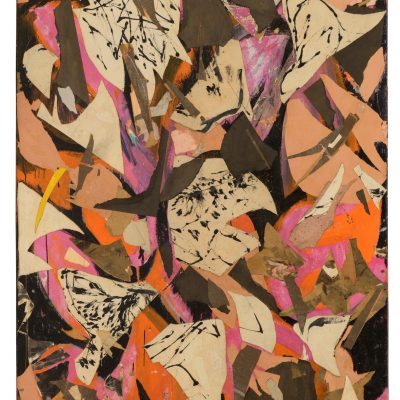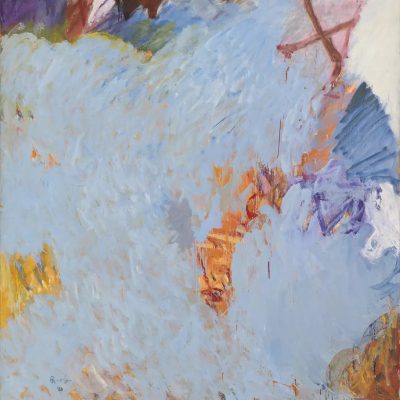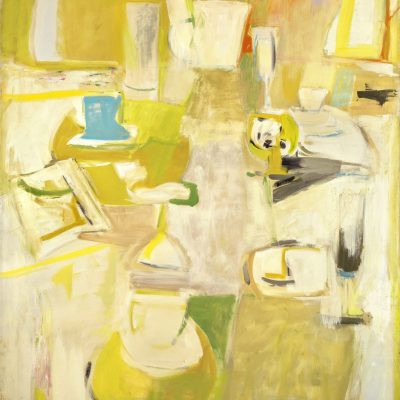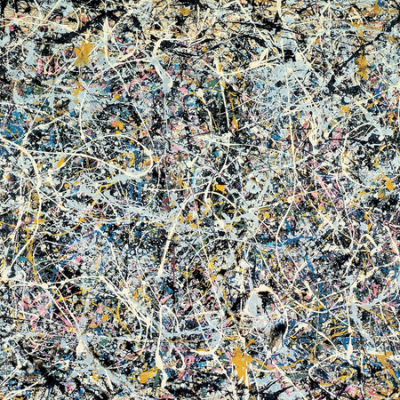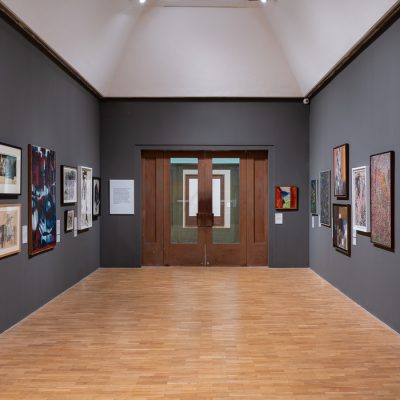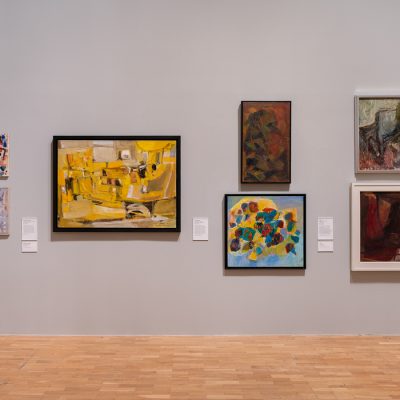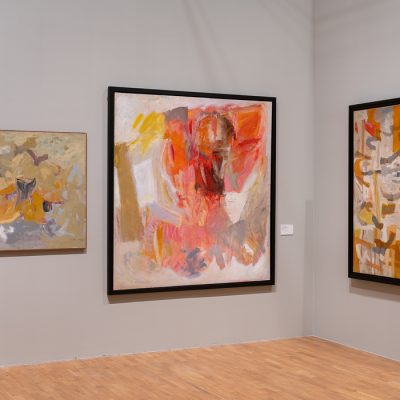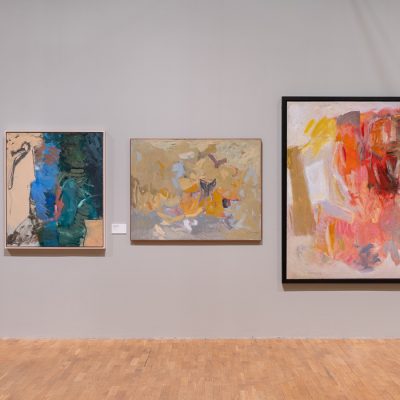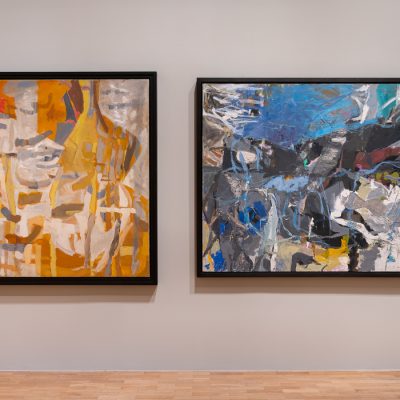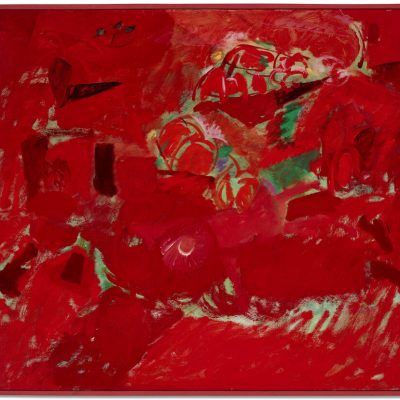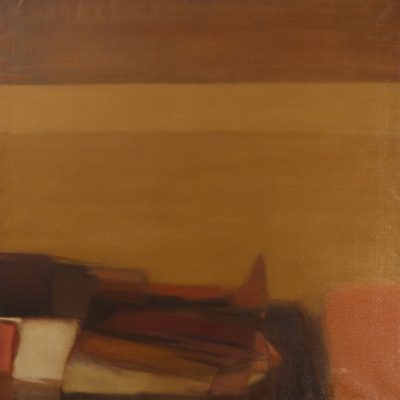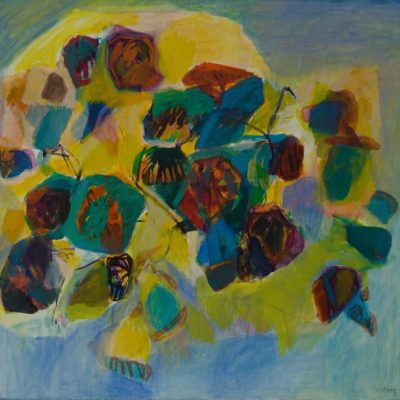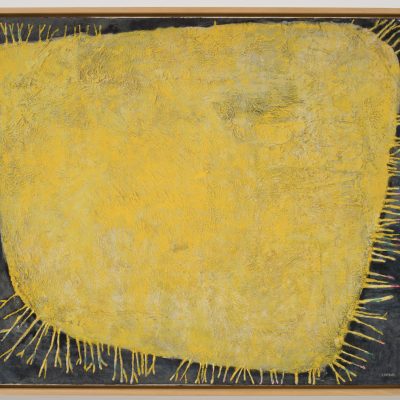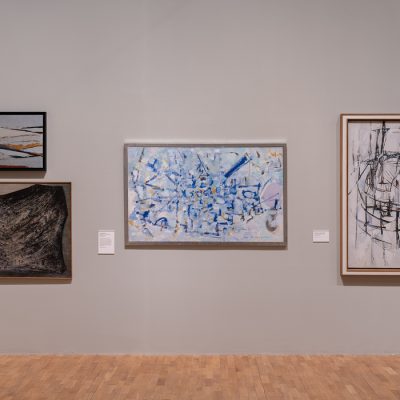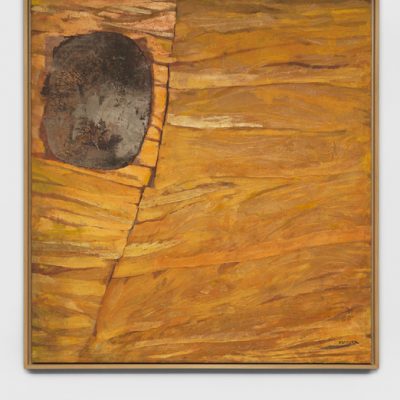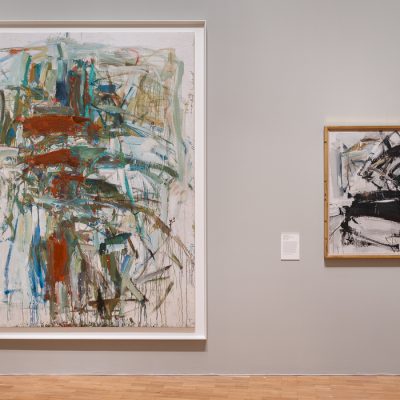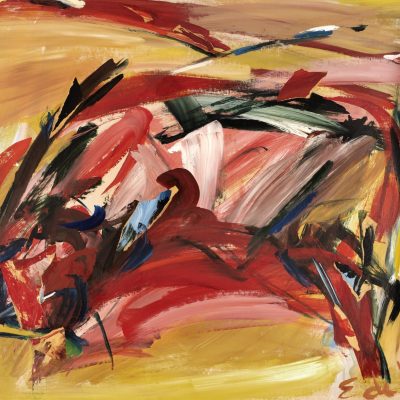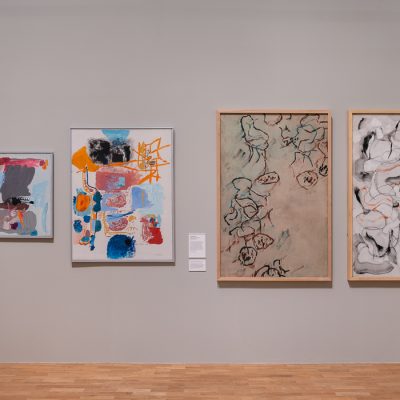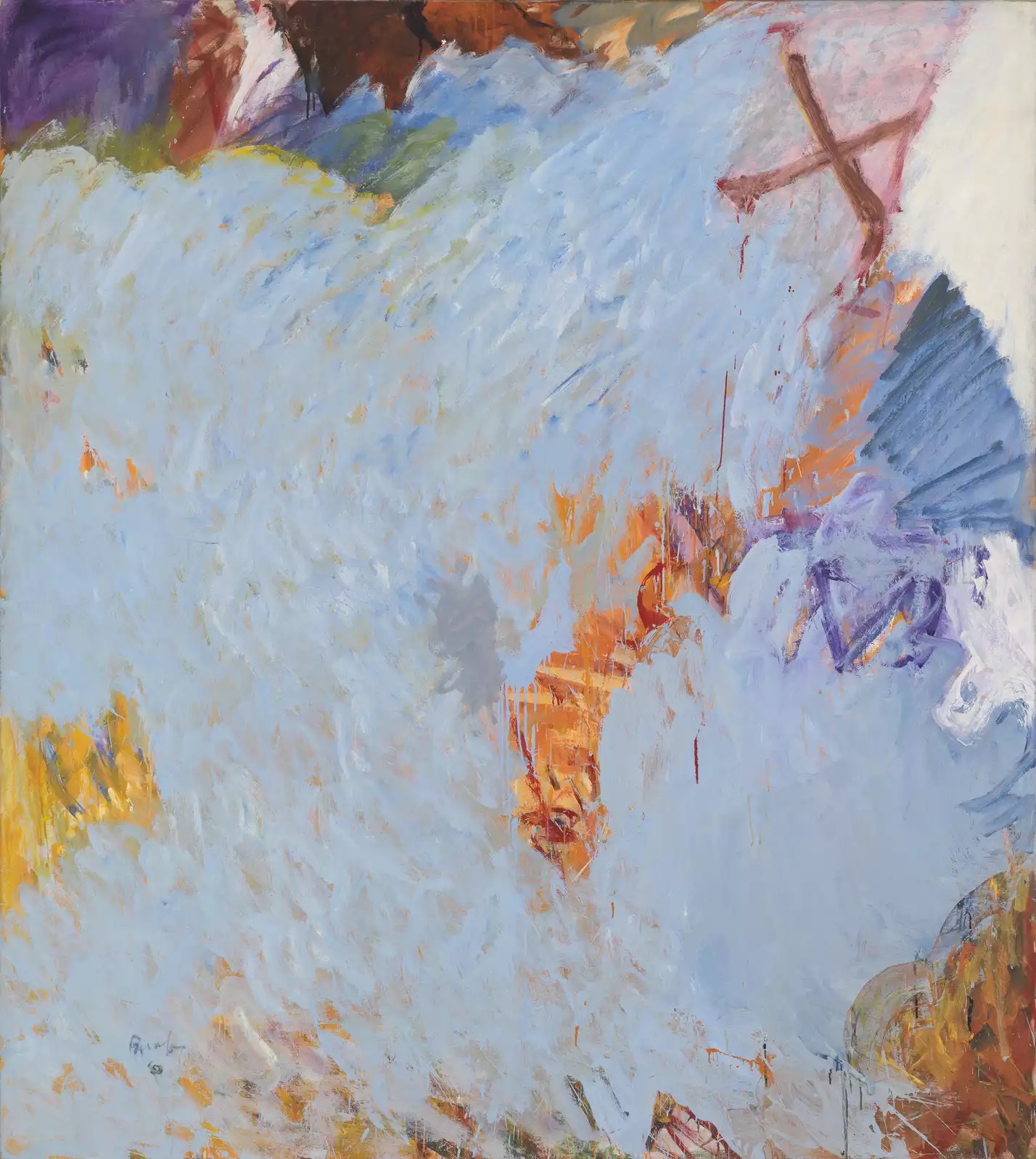
Action, Gesture, Paint: Women Artists and Global Abstraction 1940-70
Whitechapel Gallery
9 February – 7 May 2023
The Whitechapel Gallery is showcasing a major collection of 150 paintings created by 81 women artists from around the world. This exhibition focuses on the gestural abstraction movement that emerged after the Second World War and highlights the contributions of women artists who have been historically overshadowed by their male counterparts, who are often synonymous with the Abstract Expressionist movement.
The exhibition demonstrates the movement of Abstract Expressionism, which mostly recognised the USA as authentic, was not limited to this particular geography, but rather resonated across the globe. The artists featured in the exhibition share common themes of materiality, freedom of expression, perception, and gesture, while also incorporating their unique cultural contexts. This includes diverse art movements like Arte Informel in Europe, calligraphic abstraction in East Asia, and experimental and politically charged practices in Central and South America, and the Middle East.
The exhibition is arranged thematically, focusing on five themes. It opens with Helen Frankenthaler’s four-metre-long abstract painting April Mood (1974).
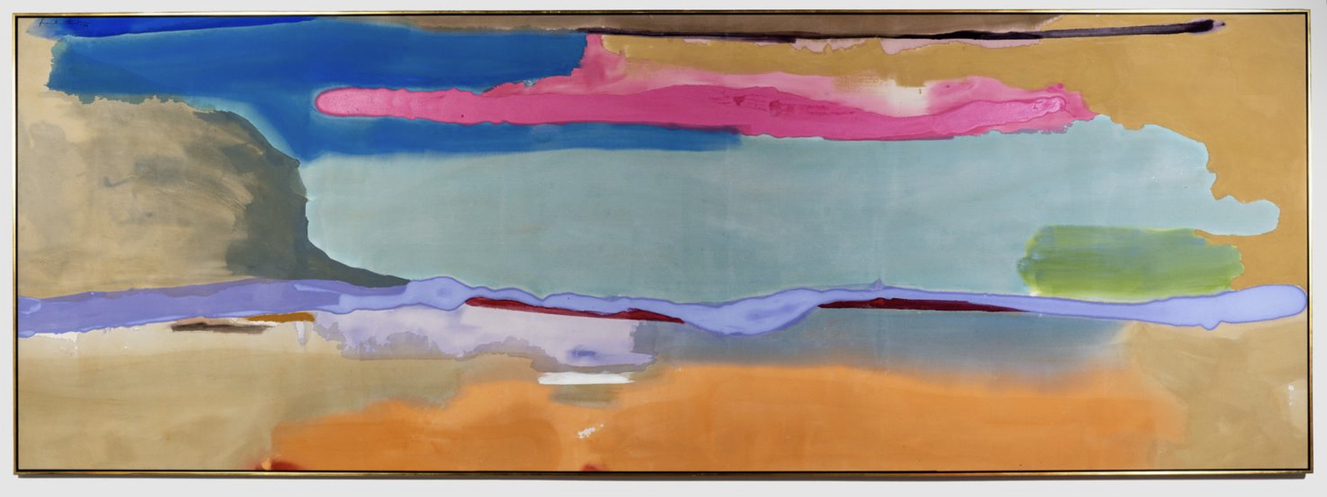
Helen Frankenthaler April Mood 1974 Acrylic on canvas 152 x 434 cm Courtesy of ASOM Collection © Helen Frankenthaler Foundation, Inc. / ARS, NY and DACS, London 2022
The opening section, Material Process Time, examines how artists were exploring the variable physical characteristics of paint, abandoning many of the accepted conventions around structure and composition.
Next section is Myth Symbol Ritual, the exhibition goes on to examine the ways in which artists were using painterly expression to explore themes of mythology and symbolism.
The third theme, Being Expression Empathy, brings together works by artists which, through explorations of the self, demonstrate an immediacy, where pure emotion appears to be translated directly onto the canvas.
The fourth grouping artists of the theme Performance Gesture Rhythm, whose abstract paintings and gestural brushstrokes had strong associations with dance, music and other forms of performance are brought together.
The final part of the exhibition, Environment Nature Perception, considers how artists turned to their surroundings and environments as subject matter, including townscapes, seascapes and rural landscapes.
Alongside established figures associated with Abstract Expressionism, such as Lee Krasner and Helen Frankenthaler, the exhibition also features relatively unknown artists like Mozambican-Italian artist Bertina Lopes and South Korean artist Wook-kyung Choi. More than half of the works on display have never been exhibited in the UK before.
The exhibition will travel to France and Germany after London’s show:
Whitechapel Gallery, London, UK, 9 February – 7 May 2023
Fondation Vincent Van Gogh Arles, France, 3 June – 22 October 2023
Kunsthalle Bielefeld, Germany, 2 December 2023 – 3 March 2024
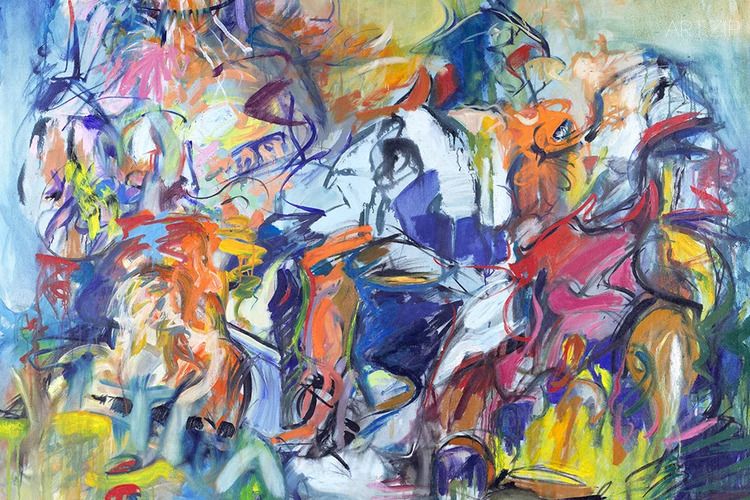
Idyll II (detail; 1956), Miriam Schapiro. Courtesy the Levett Collection; © Estate of Miriam Schapiro/ARS, NY and DACS, London 2022
Interview with Erin Li:“[…]we really want to give the full stage to women artists”
150 works by 81 artists, the walls of the two floor spaces are densely packed, creating a ‘crowded’ feeling. This is an ambitious exhibition, one might think, why not leave more space between the works? This is not the usual curatorial approach taken by the Whitechapel. With this and that questions, we had a lovely conversation with one of the curators, Erin Li. Li offered valuable insights into the sources of inspiration, curatorial processes, and the significance of women’s art history, providing us with a fresh perspective to ‘listen to the voices of these women artists’.
AZ: What prompted the selection of the theme “Action, Gesture, Paint“? And what is the rationale behind gathering such a large number of artists in one location?
EL: We think this is a long overdue exhibition. As you’ve seen around the world, recently, Abstract Expressionism as a movement has gained a lot of attention, especially in the US and the UK, there have been some survey exhibitions. However, most of the focus has been on white male artists and especially US-centred. After three to four years of research, we realised in the period of the 40s to the 70s, these trials of gestural abstraction were in a lot of places across the world. We also identified that, because it’s a post World War II moment, and people were really longing for a sense of liberation and resistance. That’s why we think it’s really important to highlight this kind of people, coming to more connections with their bodies, really thinking about painting, the action and all these things, and then also approaching the theme from a more global and feminist approach.
AZ: When was the idea of the exhibition conceived, and how long did the preparation take?
EL: The idea started around 2016. The very initial seeds of this exhibition were sown during a big exhibition in Denver. It was mainly focusing on women artists working in Abstraction Expressionism in the US. They approached the Whitechapel Gallery, suggesting to be a tour partner, but then due to a lot of logistical reasons, we couldn’t make it.
The former director of Whitechapel, Iwona Blazwick, really liked the idea. After some research, Iwona and Laura Smith, the lead curator of the exhibition, decided to turn it into a global exhibition and to expand the width of the theme. So that’s when they started to research and look around to see whether it’s possible to also hold an exhibition here in the UK, with works close to us. As you know, firstly, shipping everything from the US or from other parts of the world is very expensive, and secondly, it’s not environmentally friendly.
In the end, with this exhibition, we found a lot of lenders in Europe, so it’s much easier to borrow from them. And then for things from Latin America or other parts of the world, we tried to consolidate them in the US and then ship them over. There were two big shipments, plus some works which are already in Europe. We decided to tour most of them in France and Bielefeld in Germany after Whitechapel’s show finishes. So it’s kind of making better use of the works while they’re there.
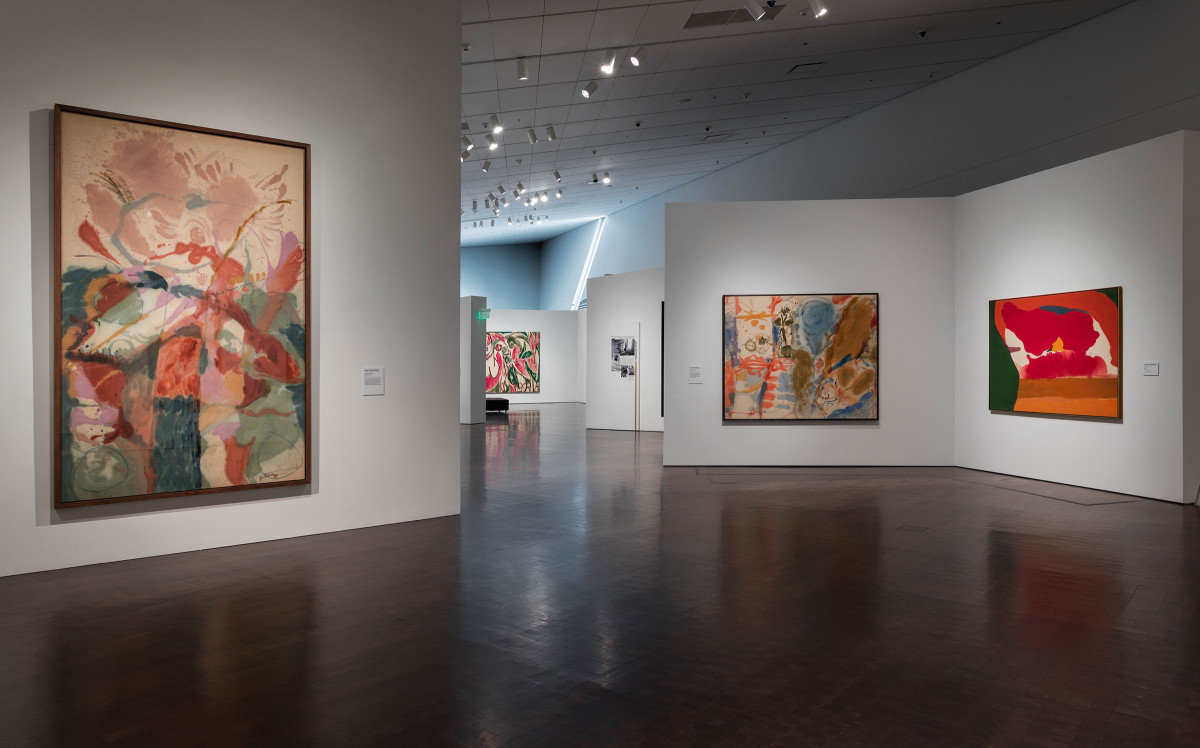
A photo of “Women of Abstract Expressionism” at the Denver Art Museum,” in VoCA Journal, November 11, 2016, https://journal.voca.network/charting-a-course-for-the-helen-frankenthaler-foundation/2016-denver-art-museum_women-of-ab-ex_2400w/
AZ: It’s an ambitious exhibition. How did you go about researching and sourcing women artists from various parts of the world for this exhibition?
EL: It’s a very global outreach, and it’s really difficult for our team to have all the expertise, so we have an international curatorial board, including Iwona Blazwick. Elizabeth Smith, who is the director of Helen Frankenthaler Foundation in the US, knows so much about these American artists particularly. And Joan Marter, a very recognised art historian, was also curating and writing in this field. Especially when it comes to performance and gestural painting, she is so knowledgeable. And also Agustin Perez Rubio, he was an expert on Latin America art and beyond.
We also have a team of three curators, Laura Smith, myself, and Candy Stobbs. I tried to contribute a bit more of my knowledge about Asia. When I came into the project, I realized they were struggling to find artists from South Asia. So I think this international mix of the curatorial team really helped with researching.
We researched a lot of the exhibitions, the major exhibitions from the past five years helped us identify some artists, but we also want to find amazing artists who are a little bit unrecognised.
Apart from that, talking to museums and individual collectors played a really important role. For instance, Christian Levett, who has his own museum and collection, has been focusing on women artists’ who work on abstraction for many years. Talking to lenders helped us locate a lot of works and galleries who also helped us reach private collections. Because we realise that a lot of women artists are commercially not as successful as a lot of the male counterparts, e.g. Jackson Pollock, their works have already been selling at millions. There’re still a lot of women artists in this show who haven’t sold most of their works yet.
At the same time, we learn from the galleries who represent their estate or from their offspring. So it’s interesting that the research of this show is from all the approaches possible, sometimes we have to use Google search. One interesting thing that Laura shared with me, is, when she didn’t have a clue about a particular context, she would search ‘the daughter of, or the mother of, or the wife of some famous male artists’. Oftentimes they have something to do with art making. They’re either gallerists or they are artists themselves. That’s how we actually found several artists in this exhibition. But because in that political environment, in many parts of the world, women were not encouraged to become artists, or they were starting to become but their status is not compared to male artists. They’re not as famous now in our history. Although they were showing and they were really active in those groups in New York at that time, they felt they were not supported enough.
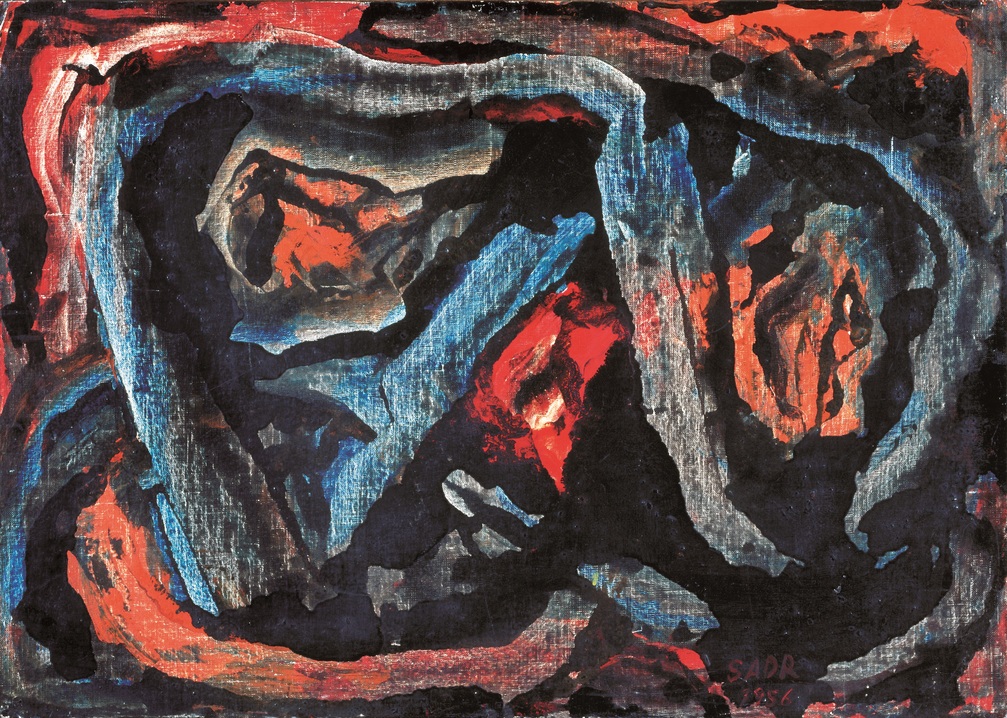
Behjat Sadr, Untitled, 1956, Oil on wood, 53cm-50cm. Courtesy of Behjat Sadr Estate © ADAGP, Paris and DACS, London 2022
AZ: As you mentioned, you have different curators to select the artists. Is there a particular set of criteria or principles that you follow when selecting artists?
EL: Yes. We definitely want the geographical breadth. So we try to cover different areas. For that, of course, the quality is really important, and whether it fits the theme. We have seen a lot of amazing works, but it’s more of a geometrical abstraction, and it just doesn’t fit the theme. So we really need to focus on whether we have this very gestural and very action heavy element to it to make the show cohesive enough. We had a lot of meetings within the whole curatorial board. We were meeting on zoom all the time and going through a much bigger shortlist of artworks, but then we had to make a lot of painful decisions to take out works. And even today, we still know it’s a little bit cramped in some rooms. But In this context, because these artists really deserved recognition. We just tried to include as much as possible and highlight them.
AZ: In what way does this exhibition challenge the dominated notion by white male artists in Abstract Expressionism?
EL: We definitely feel the male artists, and the US has gained a lot of attention. Then we realised, for instance, in Korea, around the 40s and 50s, there was also this Art Informel movement. It was a deliberate strategy for the artists to resist the National Art Exhibition system organised by their government. After looking at all these different trends, we realised this gestural abstraction is not an US-centred movement. Actually, there were so many interconnections between different parts of the world.
There are a lot of artists in the show from Korea, Japan and China, who travelled or later moved to the US or Europe to study and then exchange took place. It’s not just like the US being the centre and that everyone comes here and then makes art together. It’s also a lot of influences among different people, like artists who were travelling. Like the US artists, they travelled to Europe, to different parts of the world and they were influenced by local artists. Things happening, art trends happening elsewhere. So that’s what we wanted to highlight.
When you look at the artists’ biography in the catalogue, you would find out it was a period when ideas really started to travel. And it’s just so interesting their life stories, like different places they have lived in, and especially after the war, with a lot of political shifts in the world. They have moved to neighbouring countries or moved across continents to pursue something. So that’s why we also took the time to really research each one of them and then we have bios of all the 82 artists. In this show we have 81 But then there’s also Maria Lassnig, who will be on the other legs of this exhibition. So yeah, 82 of them. We researched and we wrote a bio and we even found a quote, because we want it to also be very relatable and inspiring. We really want to bring the life stories of how the environment when you are not encouraged or when you don’t have enough support. They still strive to make art and although they were not necessarily that much seen back then, today we finally see their value and we celebrate them.
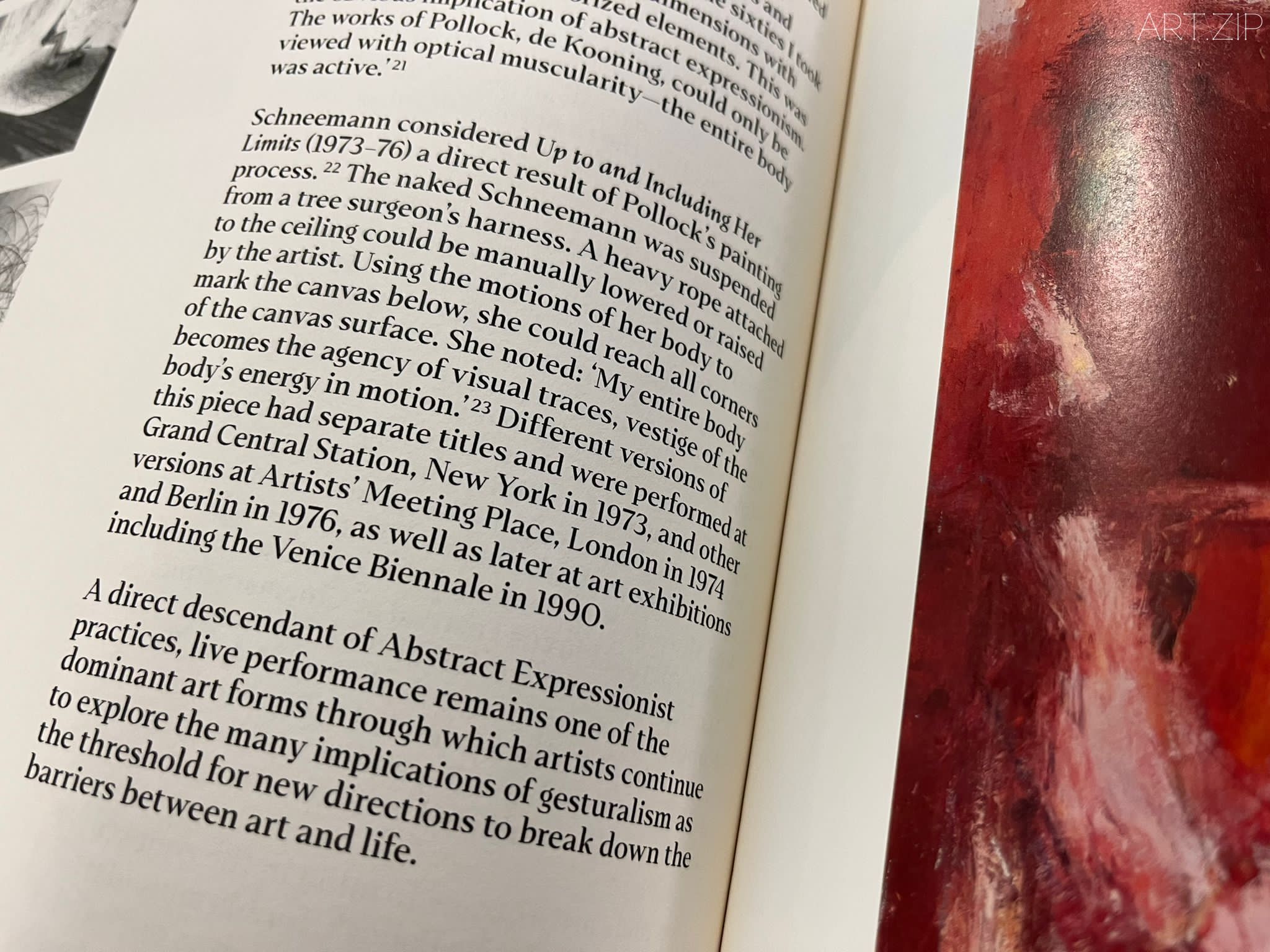
AZ: How does the exhibition show the struggle and strength from female artists? What are they common with and different from white male artists?
EL: I think it’s really interesting when we research their bios and their words. A lot of them are mentioned ‘I never imagined becoming an artist. Because as a woman, I just didn’t know it’s a thing. Because everyone surrounding me are male artists.’ So they were actually in a lot of adverse situations where they were discouraged. Janet Sobel pioneered this dripping technique and was already showing in the early 40s, and Jackson Pollock also came to see it, Clement Greenberg also saw it but then dismissed it as ‘a housewife’s painting’.
When they lived in this environment, they still kept on. I think that’s a major difference between the women artists, their resilience, and then also their flexibility with art practice. A lot of the male artists had huge studios, especially in the US. You can see them working with large canvases, also because they have the resources, their financial situation supports them to buy big canvases. In contrary to that, a lot of women artists had to use what they already had, used their kitchen as the studio, or just used whatever canvas they can afford. So you can see in the exhibition, there’s a small gallery where we feature the more intimate works, and to highlight how they really just find whatever opportunity to make art.
AZ: Would it be appropriate to suggest that female artists during that time created art simply because they enjoyed it, unlike male artists who may have sought recognition or commercial success? Despite knowing that they had limited opportunities for visibility, they persevered in their pursuit. Therefore, can we say their art had a certain purity to it?
EL: I think it’s possible to say that. Commercially we definitely have a lot of the male artists who are very successful. But also, a lot of them were working side by side, like Lee Krasner and Jackson Pollock, or Betty Parsons was running her own gallery and representing many of these both female and male artists. Women were playing roles, definitely. But then when we are writing our history, they are almost eliminated from the narratives. So it’s really important for us today to look back and then notice that they were there. They were part of the scene. Just somehow, commercially, they didn’t receive the same level of success. It’s really crazy. Also in the other sister exhibition at the Whitechapel, like Shigeko Kubota. She was working so much alongside Nam June Paik, but she’s definitely not as famous as him.
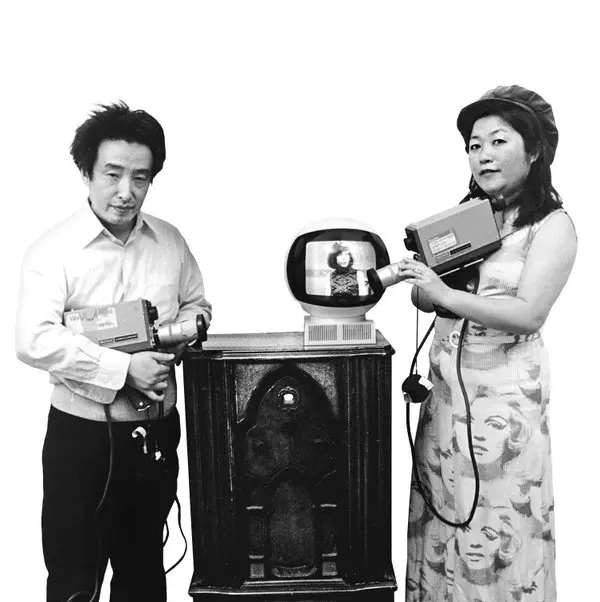
The video artist Shigeko Kubota, a central figure in the Fluxus movement, with her husband, Nam June Paik, in New York. Credit : Tom Haar
AZ: After speaking with you, now it all makes sense to see such a large number of women works in one exhibition all at once.
EL: Yes. We also know it could be controversial to make an exhibition of only women artists. But why do we do that? It’s because when you look at the generic exhibitions about gestural abstraction, they just either don’t have single women artists or just have like one or two among 20 other male artists. We don’t want to repeat that. So that’s why we really want to give the full stage to women artists.
AZ: If we want to learn more about the history of women artists, would you like to share some literature or films that coincide with this exhibition?
EL: Yes. There’s a desk in the bookstore downstairs, where we selected a lot of related literature. If you’re into storytelling, there’s Nine Street Women by Mary Gabriel. Also the book by Katy Hessel, The Story of Art Without Men, which has been a really popular book recently. There are some books people can read, but of course, a lot of them still come from a Western perspective. When we researched a lot of these artists from other parts of the world, the non-western world, we realised that there’s not much being written about them or not much being published. So it’s still quite a pity and we hope this exhibition inspires more scholars to come, to research and publish more.
AZ: Are there any personal favourite artists in the exhibition?
EL: Wook-Kyung Choi, Fanny Sanín, Nasreen Mohamedi, Sonia Gechtoff, Judith Godwin, Ida Barbarigo, Helen Frankenthaler etc.
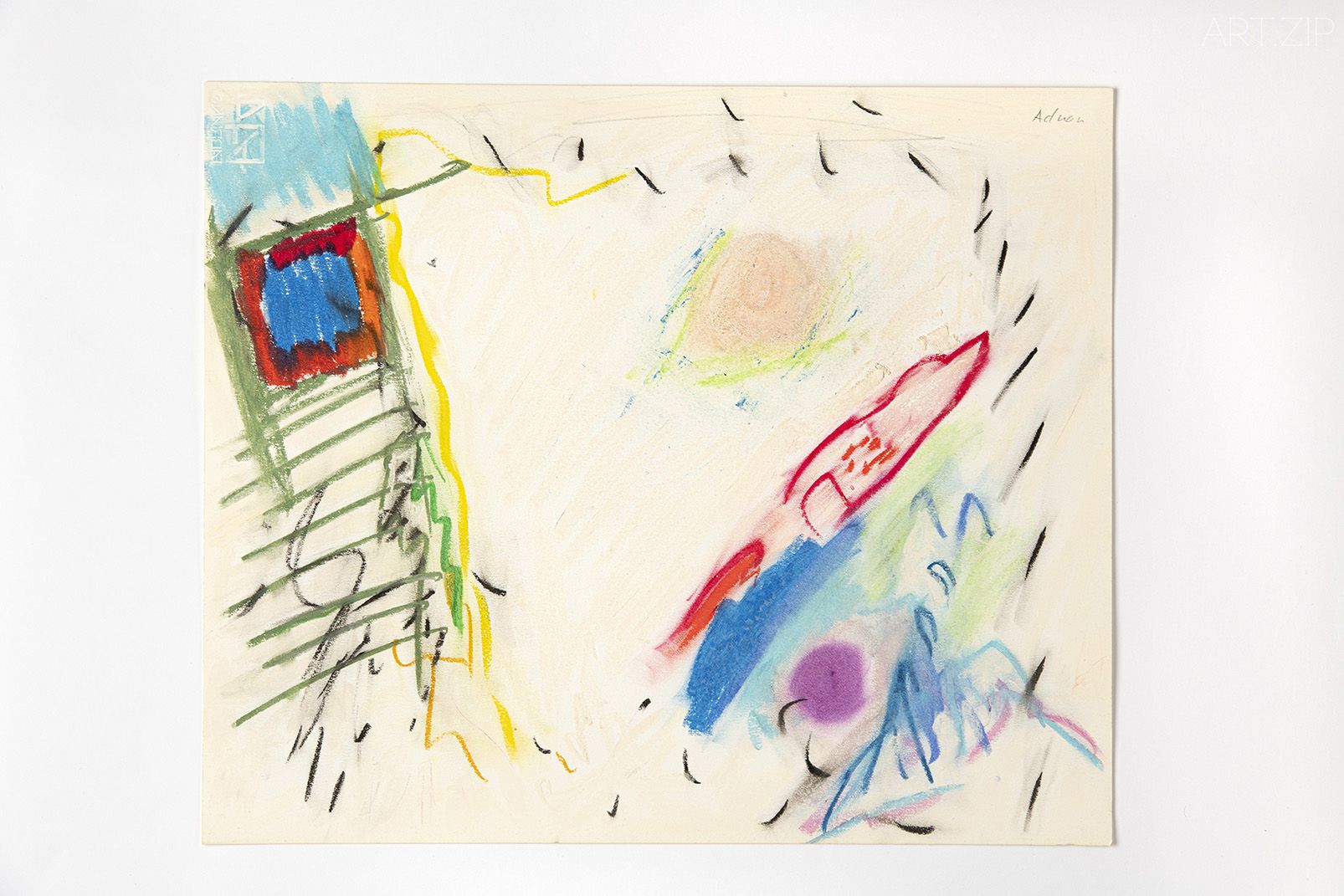
Etel Adnan, Untitled,1960, Ink wash and pastel on Paper 22.5 x 26.5 cm © The Estate of Etel Adnan / Courtesy Galerie Lelong & Co / Photo Galerie Lelong & Co
動作、手勢、繪畫:1940-1970女性藝術家與全球抽象藝術
倫敦白教堂畫廊
2023年2月9日至5月7日
白教堂畫廊現正舉辦的大型展覽名為《動作、手勢、繪畫:女性藝術家與全球抽象藝術(1940-1970)》,匯集了81位國際女性藝術家的150幅畫作。此次展覽跳脫了以往的歷史框架,通常在藝術史中,抽象表現主義運動以白人男性畫家為代表,而白教堂畫廊的這次展覽則聚焦於二戰後許多國際女性藝術家的抽象行動繪畫實踐,難得一見的好作品齊聚一堂。
該展覽展示了抽象表現主義運動的起源,不是人們慣以認為的以美國為中心,而是來自世界各地的藝術家,都在探索相似的物質性、表達自由、感知和行動等主題,賦予抽象行動繪畫以自己特定的文化背景。這包括多樣化的藝術運動,如歐洲的不定型藝術(Arte Informel),東亞的抽象書法,以及中南美洲和中東的實驗性和政治性實踐。
展覽按五大主題劃分,以海倫·佛蘭肯瑟勒(Helen Frankenthaler)的四米長抽像畫《四月心情(April Mood, 1974)》 開場。 第一部分《材料-過程-時間》首先展示了藝術家如何探索顏料千變萬化的物理特性,突破了許多結構和構圖的傳統慣例;接著,展覽的第二部分《神話-符號-儀式》展現了藝術家使用繪畫語言對神話和象徵主義主題的探索;第三部分《存在-表達-共情》匯集了藝術家通過對自我探索的作品,展示了一種直接性,將情感純粹而直接地轉化到畫布上; 第四部分《表演-手勢-節奏》展現的是與勢象筆觸有很強關聯的舞蹈、音樂和其他表演形式的藝術家作品聚集在一起;展覽的最後一部分《環境-自然-感知》展示了藝術家如何以周圍環境和環境作為主題進行創作,包括城市景觀、海景和鄉村。
這次展覽不僅展出了代表抽象表現主義的知名藝術家李·克拉斯納(Lee Krasner)和海倫·佛蘭肯瑟勒的作品,並同時展出了許多鮮為人熟知的藝術家作品,例如來自莫桑比克-意大利的藝術家寶蒂娜·洛佩斯(Bertina Lopes) 和韓國藝術家崔旭京 (Wook-kyung Choi)。展覽上超過一半的作品此前從未在英國公開展出過,而展覽期結束後作品將前往法國與德國進行巡展,具體展期如下:
英國倫敦白教堂畫廊,2023年2月9日至5月7日
法國阿爾勒文森特梵高基金會,2023年6月3日至10月22日
德國比勒費爾德美術館,2023年12月2日至2024年3月3日
專訪李伊寧(Erin Li):“我們真的只想把整個舞台交給女性藝術家”
150張作品,81位畫家,白教堂畫廊的兩層主展館牆面都被排得密密麻麻,不得不說,觀展的第一印象是“擁擠的”,這是一個龐大且雄心勃勃的展覽。為什麼不少展一些,讓作品之間都有呼吸的空間?這顯然不像是白畫廊教堂一貫的策展模式。我們帶著疑問與策展人之一的李伊寧(Erin Li)進行了討論。就展覽靈感來源、策展思路和過程、以及女性藝術史的重要性等話題,李伊寧為我們進行了詳細的解答,一一解開了謎團,也同時提供了欣賞作品的新視角。讓我們再來細細聆聽這些女性藝術家難得的“發聲”。
AZ:你能詳細談談“行動、手勢、繪畫”這個主題的出發點,以及展示這81位國際女性藝術家的作品的重要性嗎?
EL:我們認為這是一場姍姍來遲的展覽。大家已經在世界各地,尤其是在美國和英國,看到了許多相關的研究展覽。近年來抽象表現主義雖然受到了很多關注,但大部分焦點都集中在白人男性藝術家身上,尤其是以美國為中心。 經過三、四年的研究,我們意識到在上世紀40年代到70年代期間,世界上很多地方都有這種手勢抽象藝術(gestural abstraction )的嘗試。 它代表了第二次世界大戰後人們渴望的解放和反抗精神。我們認為強調這類藝術家是非常重要的,他們更深入地將身體、繪畫、行動以及其他相關元素結合起來進行藝術實踐,同時,我們也將從更加全球化和女性主義的角度來探討這個主題。
AZ:這個展覽的緣起是什麼?準備了多長時間呢?
EL:這個展覽的想法始於2016年,最初是在美國丹佛舉辦的一個大型展覽中萌生的。那個展覽主要關注在美國從事抽象表現主義風格的女性藝術家,主辦方找到了白教堂畫廊,認為我們可以成為巡展的合作夥伴,但後來由於種種物流的原因無法實現。
上一任的白教堂畫廊總監伊娃娜·布拉茲維克(Iwona Blazwick)很喜歡這個想法。經過一些研究,她和勞拉·史密斯(Laura Smith),也就是這個展覽的主策展人,決定要做成一個全球性的展覽,擴大主題的寬度。於是我們開始研究,四處調查,看看是否有可能在英國本土也舉辦一個展覽, 展出本土以及周邊國家的作品。如果要把所有作品都從美國運過來,第一,成本很高,第二,並不環保。
因此,我們最終在歐洲找到了很多借展方,這樣借展作品就變得可行多了。 而對於來自拉丁美洲或世界其他地區的作品,我們在美國統一集中起來一併運送,有兩大貨櫃。最後加上已經在歐洲的作品,組成了這次展品數量龐大的展覽。在展覽結束後,我們還會繼續在法國和德國進行巡展,這樣這些已經在歐洲的作品就能更好利用起來,呈現給更多觀眾。
AZ:這次展覽的野心很大啊,你們是怎麼發現這些遍佈全球的藝術家呢?
EL:是的,團隊裡很難有熟知各個地域藝術家的專家,因此我們有一個國際策展委員會,包括伊娃娜(Iwona Blazwick);還有美國海倫·弗蘭肯塔勒基金會的董事——伊莉莎白·史密斯(Elizabeth Smith),她對於這些美國藝術家瞭如指掌;還有瓊·馬特 (Joan Marter),她是一位非常知名的藝術史學家,也是該領域的策展人和作家,尤其是在行為和手勢繪畫方面,她造詣很深;而奧古斯丁·佩雷斯·魯比奧(Agustin Pérez Rubio)則是拉丁美洲等區域藝術的專家。
我們還有一個由三位策展人組成的團隊,勞拉·史密斯(Laura Smith)、我和坎迪·斯托布斯(Candy Stobbs)。我嘗試貢獻更多關於亞洲藝術的知識和資訊。當我參與這個項目時,我發現他們並不是很知道怎麼尋找來自南亞的藝術家。因此我認為策展團隊的這種國際組合確實有助於調研。
我們研究了過去五年裡的大型展覽,看看那些已經被展出過的藝術家,同時我們也想找一些還未出名的優秀藝術家。
通過和博物館、私人藏家的交流,我們獲得了許多優秀藝術家的資源,他們在這次展覽中起了非常重要的作用。比如,克里斯蒂安·萊維特(Christian Levett),他是一位擁有自己的博物館和藏品的借展人,他多年來一直專注於收藏從事抽象藝術的女性藝術家作品。
所以說,與借展人交流幫助我們找到了很多作品,而與畫廊交流也幫助我們找到了許多私人收藏。我們發現很多女性藝術家在商業上不如很多男性同行那麼成功,例如廣為人知的傑克遜·波洛克(Jackson Pollock),他的作品以及其他同一流派的藝術家作品價格已經達到數百萬美元。但在這次展覽中的很多女藝術家,她們大多數的作品還未被出售。
同時,我們也向處理這些藝術家財產的經紀或藝術家的後代來了解她們。這個展覽的調研過程很有趣,我們運用了所有有可能的方法,有時我們不得不使用谷歌搜索。 勞拉與我分享的一件有趣的事情是,當她對特定的背景一無所知時, 她就搜索,“某著名男性藝術家的母親、妻子或女兒”,結果發現她們常常與藝術創作有關。她們要么是畫廊主,要么本身就是藝術家。這都是我們尋找藝術家的方式。因為在當時的政治環境下,在世界上許多地方,女性是不被鼓勵成為藝術家的。或者她們已經開始成為藝術家了,但她們的地位無法與男性藝術家相比。這些女性藝術家在我們現有的藝術史中並不那麼有名,但其實她們在當時的紐約團體中非常活躍地展示自己的作品,然而她們沒有得到足夠的支持。
AZ:您剛才提到,你們有不同的策展人來選擇藝術家,那麼你們在選擇藝術家時有某些標准或原則嗎?
EL:是的。 我們首先需要呈現的是地域廣度,所以我們要嘗試涵蓋不同的地區。當然,質量也非常重要,還有是否切合主題。我們看到了很多驚豔的作品,但更多的是幾何抽象,並不切合主題。 所以我們關注點在是否有這種非常手勢抽象和行動抽象的元素,讓展覽看起來更統一和連貫。我們和策展委員會召開了很多會議,瀏覽了長長的候選名單,但後來我們不得不做出很多痛苦的決定來篩選作品。儘管現在展覽看起來有點擠,空間上有點局促,因為作品太多了,但因為這些藝術家確實值得展出,所以我們盡可能多地涵蓋並展示她們的作品。
AZ:這個展覽以何種方式挑戰了由白人男性藝術家在抽象表現主義運動裡作為主導的觀念?
EL:我們發現男性藝術家和美國藝術家獲得了很多關注。但後來我們也發現,大約40年代和50年代,在韓國也有類似的不定型藝術運動。這是藝術家們用來抵制國家美術展覽制度的一種刻意行徑。在觀察了所有這些不同的藝術趨勢之後,我們發現手勢抽象風格不是以美國為中心的藝術運動。 實際上,世界不同地區之間都相互聯繫和影響。
這次展覽中就有很多來自韓國、日本和中國的藝術家,她們去美國旅遊或後來移居歐洲,她們學習藝術並互相影響,而不是說以美國為中心,每個藝術家都去美國一起進行藝術創作。許多影響是同步發生的,例如去旅遊的藝術家,美國藝術家去歐洲旅行,去世界各個角落旅行並受到了影響。我們想要強調的是,許多事件都在同步發生,這個藝術趨勢也是互相傳播、影響繼而發展的。
如果你閱讀畫冊中的藝術家簡介的話,你會發現那是一個思想傳播的活躍時期。 藝術家們的故事都非常有趣,例如她們曾經在不同的地方生活,尤其是在戰後,世界政局的變化使得她們搬到了鄰國,或者跨越洲際去追求自己想要的生活。 因此我們也花了很多時間來研究她們當中的每一位,然後有了現在這81位藝術家的所有簡歷。 在這個項目裡,我們有81位,但還有瑪麗亞·拉斯尼格(Maria Lassnig),她將參加本次展覽的其他活動。 所以應該說有82位優秀的女性藝術家。 我們進行了研究並撰寫了簡歷,甚至找到了她們曾經說過的話,我們覺得這些非常切題且鼓舞人心。
當周邊環境並不鼓勵你,或給予足夠支持的時候,這些藝術家依然努力創作,這是我們想訴說的真實故事。儘管她們在當時不被重視,但今天我們終於看到了她們的價值並為她們慶賀。
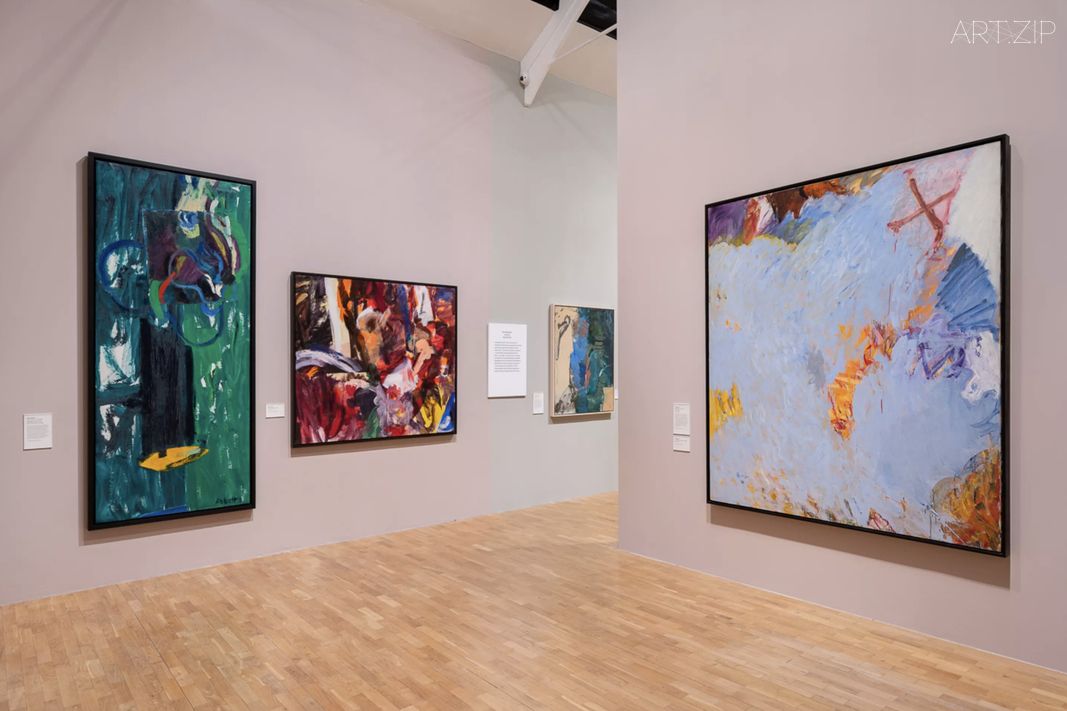
Installation view of “Action, Gesture, Paint: Women Artists and Global Abstraction 1940–70” at Whitechapel Gallery, 2023. Photo by Damian Griffiths. Courtesy of Whitechapel Gallery
AZ:這次展覽是如何展現女性藝術家的鬥爭與力量的? 她們與白人男性藝術家的共同點和不同點是什麼?
EL:我認為當我們研究她們的簡歷和言論時真的很有趣。她們當中很多人都提到:“我從沒想過會成為一名藝術家。因為作為女人,我都不知道這能算是一回事。 我周圍的每個藝術家都是男性。” 這些女性藝術家是處於這樣不利的情況下進行藝術實踐的,她們從來不被鼓勵成為一名藝術家。值得提出的是,珍妮特·索貝爾(Janet Sobel)開創了滴畫方式來進行創作,並在40年代初就已經公開展示過,傑克遜·波洛克(Jackson Pollock)來看過,克萊門特·格林伯格(Clement Greenberg)也見過,但只是將它視為“家庭主婦的畫”而不予理會。
她們在這種環境中卻仍然堅持創作。 我認為,和男性藝術家相比,女性藝術家的韌性、以及她們在藝術實踐中的靈活性是最大的分別。要知道,許多男性藝術家都有很大的工作室,尤其是在美國。你可以看到他們在大型畫布上創作也是因為有這樣充足的資源,他們的財務狀況可以支持他們購買各種大尺幅的畫布。但很多女性藝術家就只是利用她們隨手可得的東西,把廚房當工作室來用,或者只使用她們買得起的任何畫布。你可以看到,在樓上展廳中的一個小房間裡呈現的都是這些小尺寸的、更私密的作品。我們的目的就是想要著重強調女性藝術家是尋找了任何機會來進行創作。
AZ:我們可不可以理解為,在那個時期,女性藝術家創作藝術純粹是出於興趣,而不像男性藝術家可能會為了市場認可或商業成功而創作?儘管知道自己的曝光機會有限,她們仍然堅持不懈地在創作?
EL:我認為這是有可能的。商業上肯定有很多非常成功的男性藝術家, 他們當中也有很多人與女性藝術家並肩工作,比如李·克拉斯納(Lee Krasner)和傑克遜·波洛克(Jackson Pollock) ;貝蒂·帕森斯(Betty Parsons)經營著自己的畫廊並同時代理許多男性藝術家和女性藝術家。 毫無疑問,女性在當時也扮演著重要的角色。 但當我們回顧這段歷史時,這些女性幾乎從敘述中消失了。 所以對於我們來說,回顧這段歷史並發現她們的存著是非常重要的, 她們是歷史的一部分。只是某些原因讓她們在商業上沒有獲得同樣程度的成功。 這真的很瘋狂。正在白教堂舉辦的姐妹展上你會發現久保田茂子(Shigeko Kubota)和白南準(Nam June Paik)一起創作了許多作品,但她卻沒有白南準那麼出名。
AZ:謝謝你接受訪問。現在再看這些作品“擠”在一起展示也就說得過去了,真的是非常難得且重要的展示。
EL:是的。 我們也知道只展示女性藝術家的展覽可能會引起爭議。 但我們為什麼要這樣做? 這是因為在普遍的手勢抽象展覽裡,要么沒有任何女性藝術家,要么只有一兩個,而其他20位都是男性藝術家。我們不想重複這樣做,我們真的只想把整個舞台交給女性藝術家。
AZ:如果我想了解更多女性藝術家的歷史,可以分享一些呼應這次展覽的文學作品或電影嗎?
EL:畫廊書店有很多我們挑選的相關文獻書籍。 如果喜歡故事,可以看看玛丽·加布里埃爾的《九街女人》。還有凱蒂·埃塞爾的《沒有男人的藝術故事》(2022),這是最近很火的一本書。 但當然,其中很多仍然來自西方視角。 當我們研究很多來自非西方世界的藝術家時,我們意識到並沒有太多關於她們的文章或出版物。 所以還是感到很遺憾的,我們希望這次展覽能激發學者們前來觀看、研究和發表更多作品。
AZ:這次展覽中你個人最喜歡的藝術家有哪些?
EL:崔旭京、芬妮·薩寧、娜琳·穆罕默迪、索尼婭·格托夫、茱蒂絲·戈德溫、艾達·巴巴里戈、海倫·佛蘭肯瑟勒等。
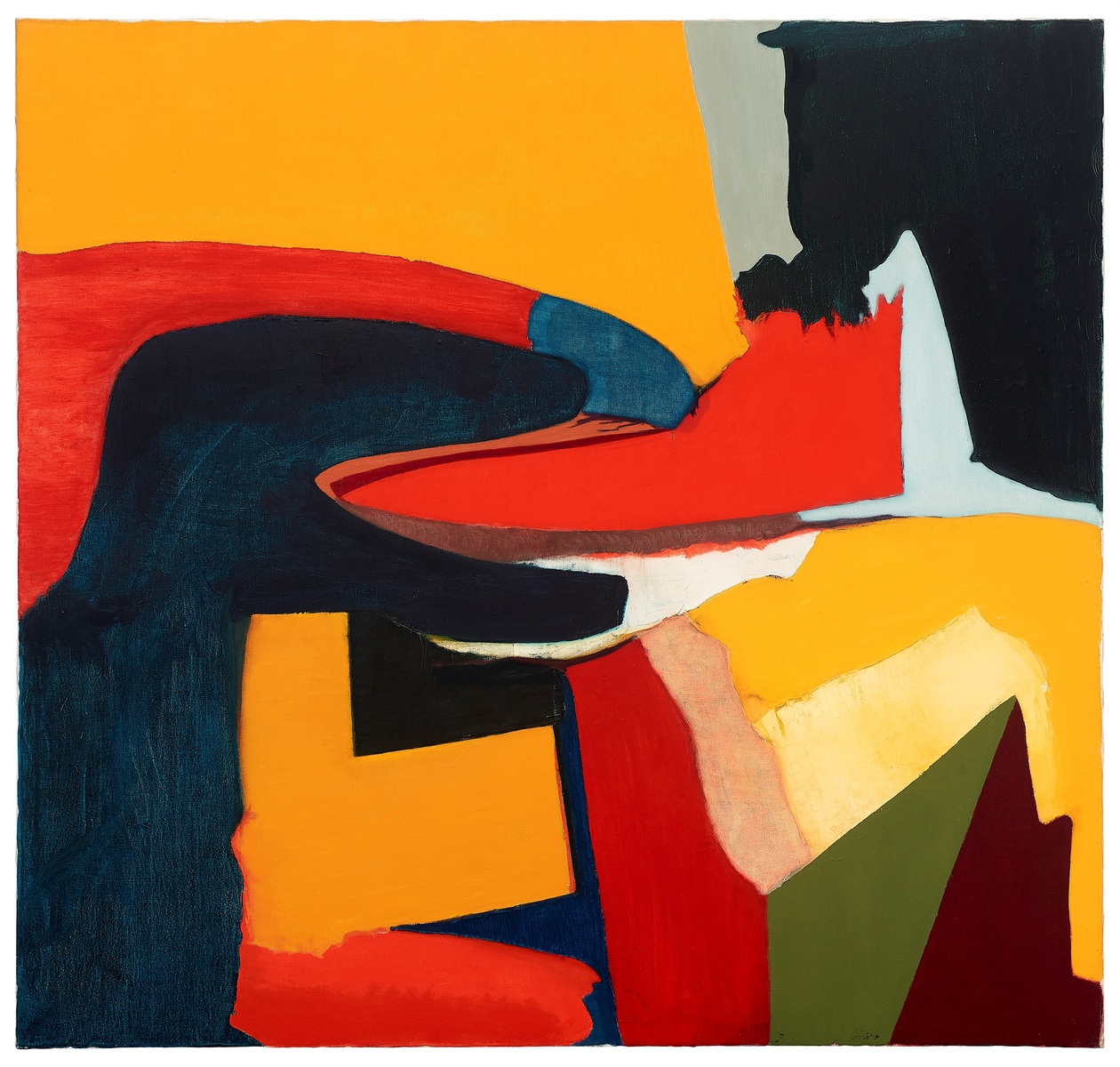
Fanny Sanín Oil No. 4 1968 Oil on canvas 157 x 150 cm Courtesy of Elisa Yu Collection © Fanny Sanín
Text and Interview 撰寫及採訪 x by Xinde Ren 任心得
Edited 編輯 x by Michelle Yu 余小悦

